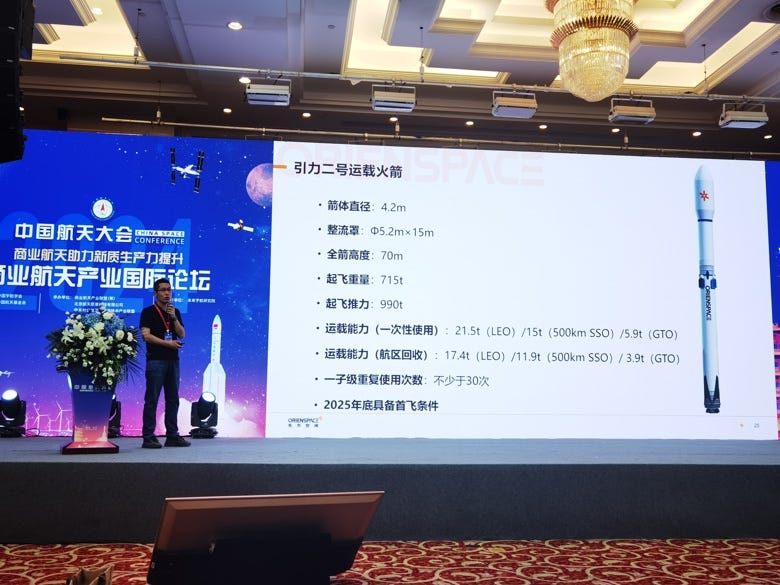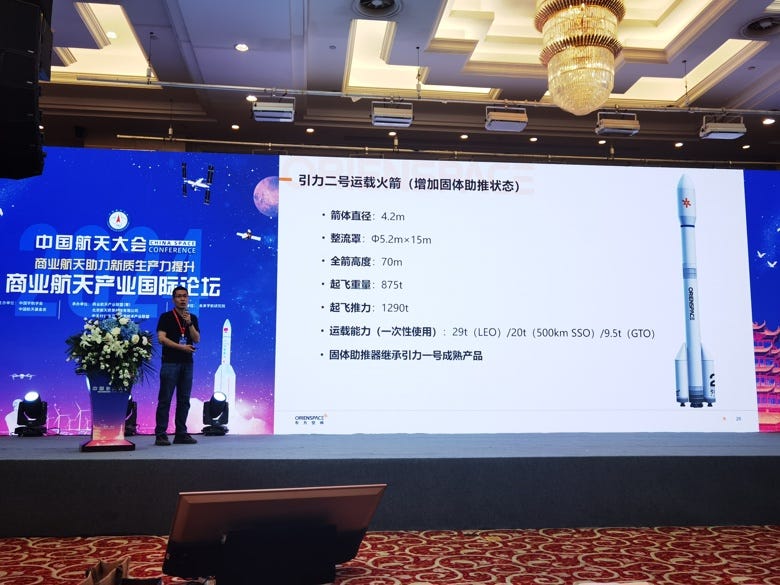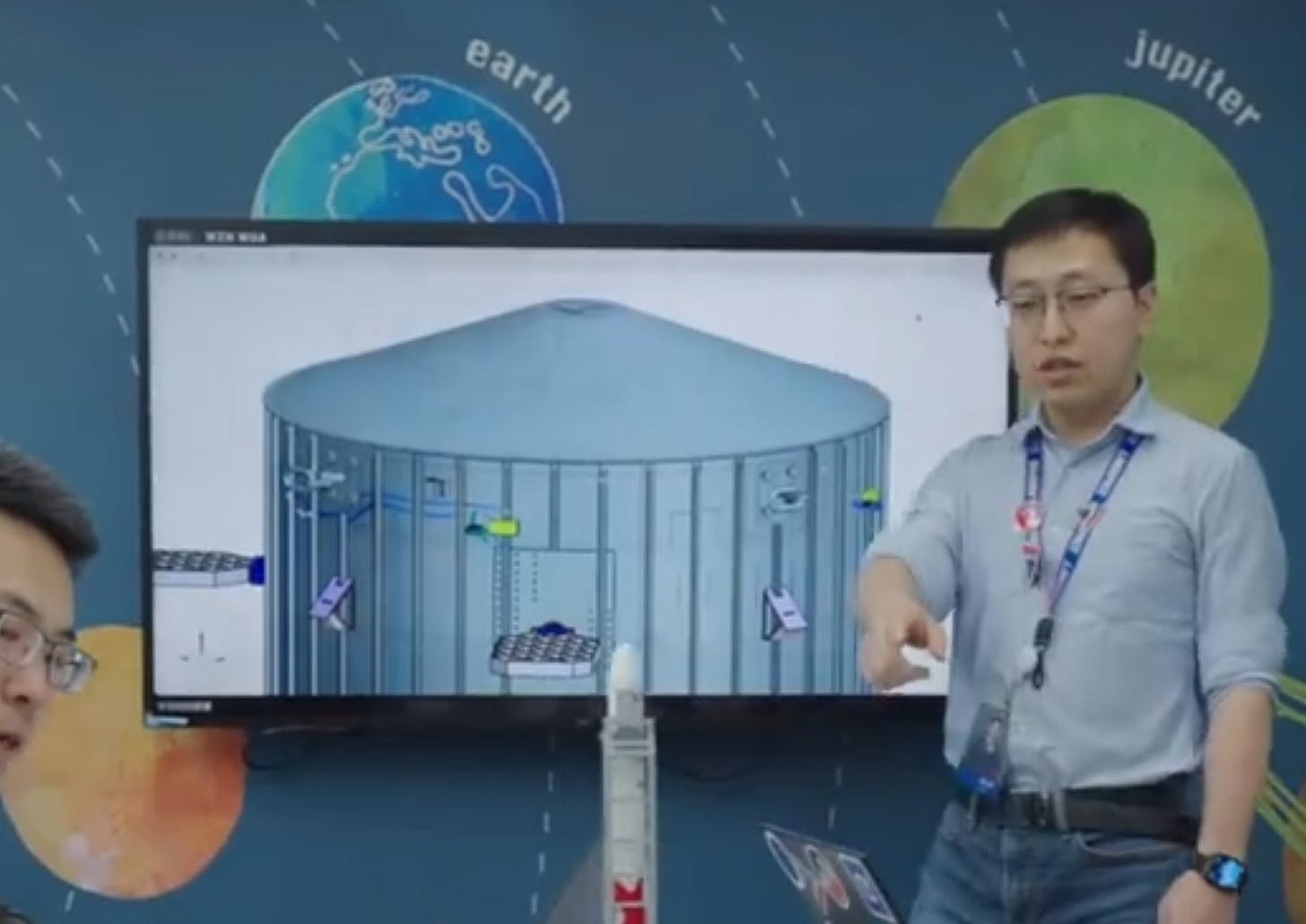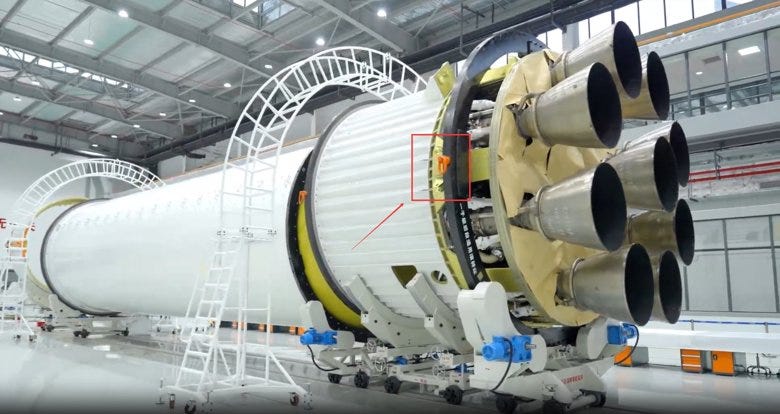Late April China Space Catch-up [28/4/2024]
This post was originally published on April 28th 2024.
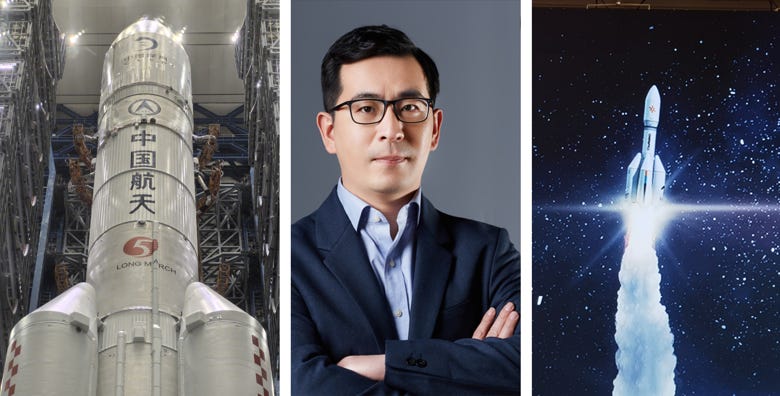
Hello again! There's been a lot going on in China's aerospace industry since we last recapped, the last recap was... w h a t... nine days ago?!? Well we have plenty to get through, so let's begin!
Chang'e 6
Naturally, the first thing to be touched on is Chang'e 6 being moved to its launchpad. The Long March 5 Y8 vehicle was moved out to LC-101 on the 27th, which provided some great photos of the rocket.
The rocket is also rumored to have had a decrease in dry mass, this has led to an extra 100 kilograms of payload capability to a trans-lunar trajectory. Chang'e 6 is stated as weighing 8,200 kilograms when attached to the rocket, Chang'e 5 weighed the same so this is likely to allow for a more specialized trajectory.
Chang'e 6 is a flagship mission for the China National Space Administration as if it is successful it will be the first mission to return samples from the far-side of the Moon! Despite the current NASA Administrator not knowing why this mission is happening, it does indeed provide scientific value as far-side samples have never been observed before. The return capsule of the spacecraft is planned to bring back 2,000 grams of lunar surface samples sometime in July, the mission has a believed duration of ~50 days near the Moon.
Interestingly, and to the further confusion of the NASA Administrator, the fairing features the logos of CNES, ESA, and SUPARCO.
CNES is providing the DORN instrument, Detection of Outgassing Radon, to study the lunar regolith and lunar exosphere.
ESA is providing two instruments via Italy and Sweden. Italy has provided the INRRI instrument, INstrument for landing-Roving laser Retroreflector Investigations, to test our laser range-finding for landers, this instrument is passive. Sweden has provided the NILS instrument, Negative Ions on Lunar Surface, which will, as the name suggests, detect and measure negative ions reflected by the surface of the Moon.
SUPARCO has provided the Pakistani-made ICUBE-Q cubesat which will be released in lunar orbit to detect ice on the surface.
The launch of the Chang'e 6 mission is currently planned for no earlier than the afternoon (China Standard Time) of May 3rd.
LandSpace
Reporters gained access to LandSpace on the 24th and talked with Zhang Changwu, LandSpace's founder and CEO. While speaking with Zhang it was reaffirmed that the company will launch four times in 2024, they are yet to launch this year, with eight planned for 2025, this is likely for Zhuque-2 alone. Zhang also stated that the company will start performing a "high-frequency launch phase" and that the 10-kilometer test hop for its Zhuque-3 hopper vehicle is planned for June.
They also found out that LandSpace can currently produce 30 engines per year, likely for Zhuque-2 which needs five per launch, with plans to scale to 100 by 2025. The increase in production will help with development of Zhuque-3 and allow for Zhuque-2's greater cadence next year. Interestingly, LandSpace is using automated laser welding for its TQ-12B engine nozzles to complete the approximately 800 welds. This technology is also reportedly being used to weld the thrust chamber and smaller component joins, the quality has been verified by hot-fire tests too. Based on similar technology used in high-quality manufacturing in China, it would not be out of the question to have the majority of engine assembly be automated. This automated welding could also be used to speed up propellant tank production. (Side note but holy shit LandSpace could have incredible profit margins).
With the increases in production and automation, LandSpace is also hoping to reduce the cost of launch in China to 40,000-50,000 Yuan Renminbi per kilogram. This is approximately 5,520-6,900 USD and three times cheaper than current costs in China.
While touched on briefly, the report confirmed the existence of LandSpace's 200-ton thrust full-flow staged combustion engine. The engine is being developed under the codename 'Lanyan' (蓝焱)/BF-20 with a preliminary review being completed sometime in 2021 along with some testing. I reached out to LandSpace to ask about the engine but was met with the usual silence. This engine will probably be used on LandSpace's post-Zhuque-3 fully reusable vehicle.
OrienSpace
OrienSpace has been sharing information about its future at the China Space Conference and in interviews this past month.
At the China Space Conference, there were a few notable takeaways. The first is that OrienSpace is planning to increase the thrust of its Force-85 engine from 85 tons to 110 tons, the specific impulse will also increase from 278 seconds to 285 seconds. This engine will be used on the Gravity-2 and Gravity-3 launch vehicles.
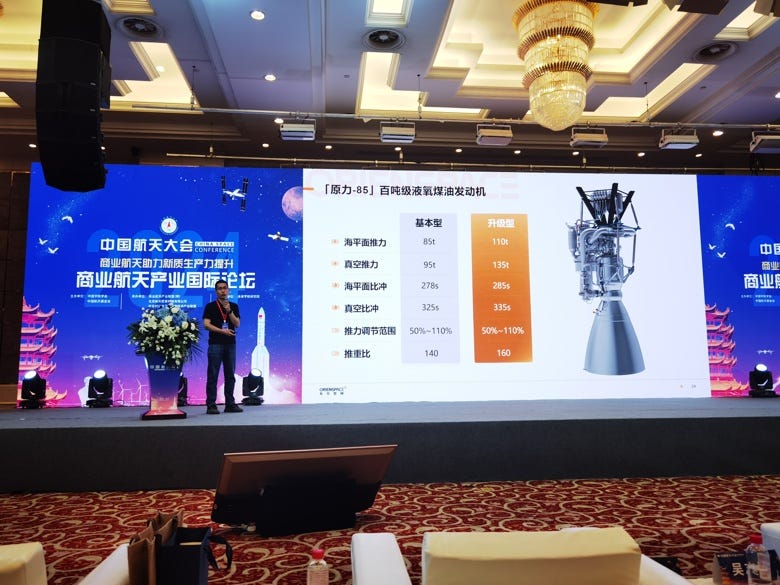
Also at the conference, the company revealed some statistics about Gravity-2. The rocket will stand 70 meters tall and weigh 715,000 kilograms fully fuelled with a total thrust of 990 tons. The two stages will have a diameter of 4.2 meters, the first-stage will have nine Force-85's with the second-stage having a vacuum-optimized Force-85. The fairing of will be 5.2 meters in diameter and 15 meters long.
In terms of performance, when reused Gravity-2 will be able to carry 17,400 kilograms to a low Earth orbit, 11,900 kilograms to a 500-kilometer sun-synchronus orbit, or 3,900 kilograms to a geostationary transfer orbit. If expended it will be able to deliver 21,500 kilograms to low Earth orbit, 15,000 kilograms to a 500-kilometer sun-synchronus orbit, or 5,900 kilograms to a geostationary transfer orbit. This is on par with the capabilities of SpaceX's Falcon 9 and trades blows with Zhuque-3 and Tianlong-3.
OrienSpace also briefly touched on the planned Gravity-2 that would be augmented by two solid rocket boosters from Gravity-1. If launched it will be able to deliver 29,000 kilograms to low Earth orbit, 20,000 kilograms to a 500-kilometer sun-synchronus orbit, or 9,500 kilograms to a geostationary transfer orbit. Surprisingly the two boosters only weigh 80,000 kilograms each while adding 300 tons of thrust, for a total of 1,290 tons of thrust with the nine first-stage engines.
On the 27th, OrienSpace's Founder and Co-CEO, Bu Xiangwei, answered questions from reporters at the 2024 Zhongguancun Forum. Curiously the first question asked was about where the company is going, Bu answered that the company is looking to gain customers from the international market via the Belt and Road Initiative due to the greater profit margins, this could also extend out to Western-based customers.
When asked about why OrienSpace attracts investors, Bu claims that Gravity-1's 4.2 ton to low Earth orbit carrying capacity allows it to have lead in the current market alongside its 50,000-60,000 Yuan Renminbi per kilogram costs, this is approximately 6,900-8,280 USD and is the lowest cost per kilogram in China. This was followed up by a question about how much Gravity-2 will cost, Bu said they are aiming for 30,000-40,000 Yuan Renminbi per kilogram (4,140-5,520 USD) and that it will debut in 2026 with two flights. He also added that two more Gravity-1 flights are expected this year and that Gravity-2 is aiming for below 10,000 Yuan Renminbi per kilogram (1,380 USD) by 2029.
Bu was also asked about cadence with him saying that this year Gravity-1 will launch two more times, with between five and eight launches in 2025, and approximately 10 in 2026.
Jiuquan Commercial Developments
Harry Stranger on Twitter released an excellent thread on the 27th with images of commercial space developments at the Jiuquan Satellite Launch Center from the day prior. I won't be uploading those images here, as Harry paid for the satellite time and has his own Patreon for the full-quality images, so if you want to see them check out the thread.
In the thread, it's now clear that construction of the Zhuque-3 launch pad is in full swing at LC-96. With preparations for a tank farm expansion also underway, the current tank farm cannot support fully fuelling Zhuque-3. The new landing pad for the Zhuque-3 hopper vehicle has completed basic construction ahead of the 10-kilometer test in June.
Harry also spotted that Space Pioneer is indeed building a launch pad for Tianlong-3 at Jiuquan. Any landing pad construction has not yet been spotted but it is likely to appear closer to flights from the pad.
Spotted at iSpace's LC-120, a new landing pad for the Hyperbola-2Y test vehicle has been built. This pad will support higher and more demanding tests from the vehicle which is testing technology for Hyperbola-3.
Re-use Hardware Appears
Now for a section where I'm going to be making some predictions, as I can't find the direct source. Ace of Razgriz released images of a Zhuque-3 hopper render and the Tianlong-3 Y1 first-stage.
In the Zhuque-3 hopper renders some small grid fins are on the vehicle. This is likely an engineering render to understand the aerodynamics prior to the test flight. Due to the size of these grid fins, they are likely so LandSpace can understand the materials needed for full-scale hardware. I don't expect Zhuque-3's production grid fins to remain this small, the hopper test vehicle also has different aerodynamics and mass distribution so full-scale grid fins may be a bad idea at this stage of testing.
Ace of Razgriz believes they have spotted a potential mounting point for landing legs on the Tianlong-3 Y1 engine section. Space Pioneer has been inconsistent on whether the first flight will attempt a landing with unofficial sources saying both. Assembly of the first-stage is yet to be completed with one of the propellant tanks missing in recent photos along with the interstage and second-stage. Once images of a more complete first-stage are released it will be easier to tell if the company aims to test landing on flight one. These points may also be for ground infrastructure mounting at Hainan Commercial Launch Pad 2, which is where Tianlong-3 is slated to debut from.





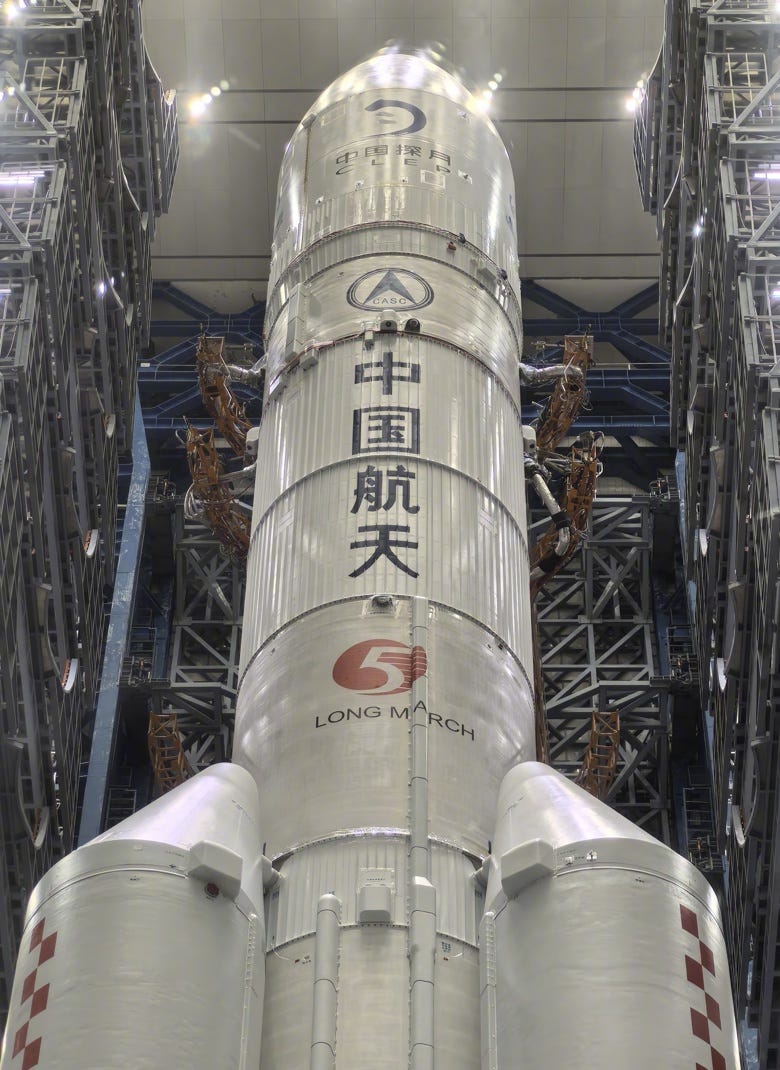
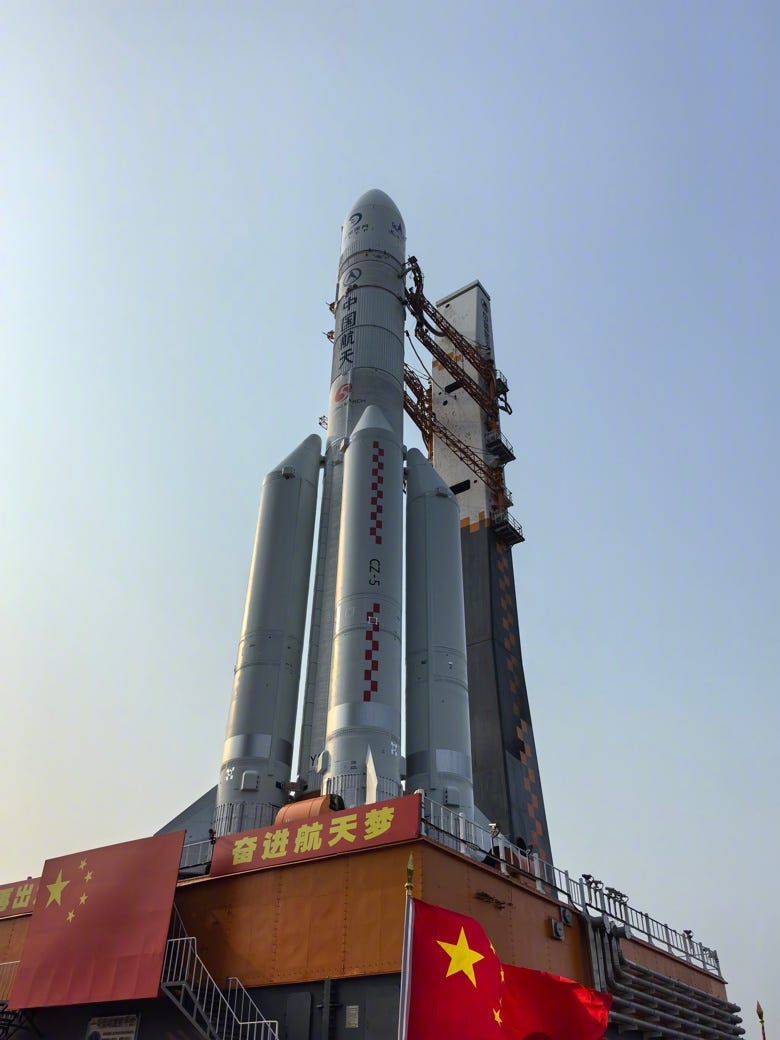
![The fairing of the Long March 5 Y8 vehicle [From Spacelens Via Wu Lei] The fairing of the Long March 5 Y8 vehicle [From Spacelens Via Wu Lei]](https://substackcdn.com/image/fetch/w_1456,c_limit,f_auto,q_auto:good,fl_progressive:steep/https%3A%2F%2Fsubstack-post-media.s3.amazonaws.com%2Fpublic%2Fimages%2F0a1549f6-99ef-41eb-987d-5abb98e55346_1216x1870.jpeg)

